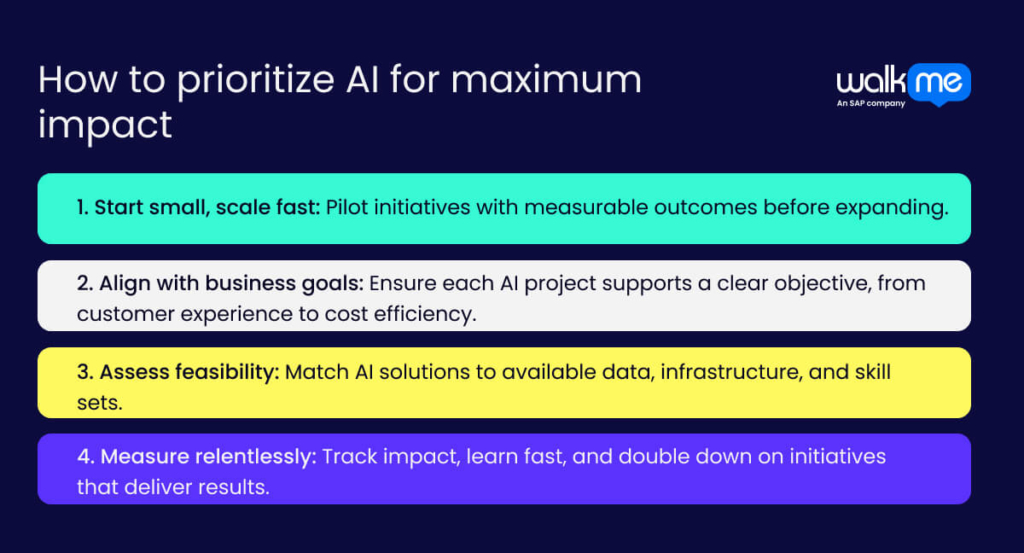Artificial intelligence (AI) drives enterprise strategy but often clashes with real-world challenges.
WalkMe’s State of Digital Adoption (SODA) 2025 finds that only 28% of employees know how to use their company’s AI applications. With enterprises running an average of 200 AI tools, the real test is making them work together across teams and workflows.
Enterprise AI’s turning point demands a mindset shift, where adoption, integration, and trust decide whether it creates impact or wastes investment.
This article explores the state of enterprise AI adoption in 2025. We’ve broken it down into the housing categories below, which reveal where the impact is happening and how organizations can turn adoption into an advantage.
Understanding the opportunity
Understanding the opportunity involves exploring the potential of enterprise AI, envisioning the desired outcomes, and identifying where adoption can create impact across teams, processes, and goals.
How does AI adoption shape competitive advantage?
Most companies use AI in some form, but the real benefit comes from how it’s applied to existing processes.
For example, a recent McKinsey report found that organizations using generative AI across different business functions achieved measurable revenue gains and cost reductions. Yet over 80% of respondents reported no meaningful impact on enterprise-wide EBIT, showing that AI alone isn’t enough.
That gap speaks volumes and is a stark reminder that technology isn’t the barrier—mindset is. Companies that treat AI as a plug-and-play solution often fail to achieve lasting returns.
Proactive enterprise AI adoption requires rethinking all areas of the business and placing pressure on leadership to adopt change.
AI Adoption case study: JP Morgan Chase
To help you understand the opportunity of AI adoption, the following case study examines JPMorgan Chase’s approach.
The bank deployed a coding assistant that boosted the productivity of tens of thousands of engineers by 10% to 20%. These efficiency gains meant engineers could focus on higher-value projects in AI and data, rather than routine coding tasks.
J.P. Morgan Chase has already identified 450 potential AI use cases, with CEO Jamie Dimon projecting that this number could rise to 1,000 by next year.
Implementing AI across the enterprise is expected to deliver $1 to $1.5 billion in impact, illustrating a disciplined AI adoption strategy.
Organizational readiness for AI
If enterprise AI adoption and implementation are to flourish, organizational readiness must be at the core, aligning people, processes, and technology to capture value. Sometimes, thinking outside the box isn’t enough, and success requires reshaping mindsets to drive organizational change.
What capabilities are required to scale AI successfully?
Scaling AI is more challenging than you think, requiring the right combination of talent, infrastructure, and organizational mindset to yield measurable results.
These are the capabilities you need to scale AI:
- Cross-functional teams: Engineers, analysts, and business leaders working together ensure AI is a force that drives tangible outcomes.
- AI centres of excellence: A central hub captures lessons, sets standards, and stops innovations from vanishing into data silos.
- AI model selection and evaluation: Choosing the right model means matching it to the problem, testing, and refining to ensure reliable and actionable results.
- Internal AI training: Authentic adoption happens when people understand, trust, and can confidently wield AI to improve their work.
How can leaders align AI initiatives with business objectives?
One of the most important takeaways for leaders is that AI doesn’t deliver value by sitting in a silo. AI only earns its keep when initiatives are directly tied to the business goals that actually move the needle.
Gartner reports that 74% of CEOs believe AI will have a significant impact on their industries in 2024, up from 59% in 2023. This data shows how important it is for organizations to develop and execute AI strategies closely aligned with strategic business priorities.

The same Gartner report also indicates that organizations with a clear AI strategy are more likely to achieve measurable ROI. Their findings suggest that organizations with a targeted AI strategy are better positioned to realize the full potential of their AI investments.
Leaders can align AI with business objectives by connecting every initiative to real-world goals and resisting the temptation to let technology outpace strategy.
Data and infrastructure
Data and infrastructure are what keep AI moving. In that regard, the true challenge lies in making data accurate and accessible so every AI decision is grounded in reality.
Why is data quality and accessibility non-negotiable in 2025?
In modern business, AI can only deliver on its promise if the data feeding it is accurate and accessible.
Fragmented systems, inconsistent records, and rigid legacy applications can turn some pretty powerful models into guesswork machines. A recent IBM study found that 42% of organizations cannot properly customize AI models due to the use of poor-quality data.
Similarly, BCG found that 74% of companies report struggling to scale AI value because of data governance and accessibility issues. These statistics clearly reveal that data is the foundation of AI success, and without it, even the most sophisticated tools fail to deliver a real business impact.
How to decide between on-prem, cloud, and edge for enterprise AI adoption
We’ve put together the table below to help you weigh the trade-offs and choose the deployment option that best balances cost, performance, compliance, and scalability for your AI initiatives.
| Factor | On-Prem | Cloud | Edge |
| Total Cost of Ownership | Higher upfront, predictable over time | Pay-as-you-go, flexible but ongoing | Moderate, depends on hardware deployment |
| Performance | Fast for internal systems, low latency | Dependent on the internet, scalable compute | Ultra-low latency, real-time processing |
| Compliance | Full control over data, easier to meet strict regulations | Shared responsibility may require extra safeguards | Data stays local, easier for sensitive info |
| Scalability | Limited by hardware | Virtually limitless, flexible | Scales for local processing, not global |
AI implementation
If the implementation stage fails, all the strategy and investment in AI evaporates, leaving tools that impress on paper but never change how work actually gets done.
How to prioritize AI for maximum impact

Focus on high-value processes and identify workflows where AI can save time, reduce errors, or unlock revenue:
- Start small, scale fast: Pilot initiatives with measurable outcomes before expanding.
- Align with business goals: Ensure each AI project supports a clear objective, from customer experience to cost efficiency.
- Assess feasibility: Match AI solutions to available data, infrastructure, and skill sets.
- Measure relentlessly: Track impact, learn fast, and double down on initiatives that deliver results.
What is a portfolio approach, and how does it reduce risk and enhance ROI?
A portfolio approach to AI means managing multiple initiatives at the same time, tracking impact, and doubling down on what works while scaling back what doesn’t.
Johnson & Johnson put this into practice with nearly 900 generative AI projects, learning that just 10–15% of these projects delivered 80% of the value. They shifted their focus to high-impact areas such as drug discovery, supply chain digital transformation, and employee support tools like “Rep Copilot,” an AI assistant for sales reps.
Technology ecosystem and vendors
The technology ecosystem and vendor category are often overlooked. Yet, they form the web connecting AI tools, data, and processes, which means getting them right can make AI adoption far more impactful.
Using open-source AI frameworks
Open-source AI frameworks give organizations the freedom to tailor AI exactly to their needs, avoiding vendor lock-in while staying in control of how models are scaled.
These frameworks can be understood as:
- Cause: Enterprises need flexibility, transparency, and control over AI models.
- Effect: Open-source frameworks like TensorFlow and PyTorch let teams adapt models, inspect code, and experiment safely.
- Benefit: Organizations speed up deployment, lower risk, and gain from community-driven improvements.
How to choose partners that accelerate enterprise AI integration
The table below makes it simple to see what matters when picking vendors who actually help your AI work at scale and deliver real results:
| What to Look For | How to Choose |
| End-to-end solutions | Pick vendors who guide projects from strategy to deployment. |
| Support for the AI lifecycle | Choose partners offering help at every stage: pilot, scale, optimize. |
| Scalability and flexibility | Ensure tools can grow with your business without breaking workflows. |
| Vendor expertise and track record | Favor vendors with proven enterprise AI wins. |
| Integration with existing systems | Confirm fit with your existing tech stack. |
| Security and compliance capabilities | Select partners who embed safeguards and meet regulations. |
Measuring business value
Measuring business growth has always been tricky, especially with AI. Traditional metrics miss the full picture, so leaders are tracking new KPIs to visualize impact across the enterprise.
Which KPIs capture AI success beyond cost savings?
The following KPIs can be used to increase the success of AI initiatives:
- Employee time reclaimed: BCG indicates that AI can help professionals reclaim 26% to 36% of their time in areas that are routine, content-heavy, and data-driven.
- Return on Investment (ROI): IBM’s study found that companies realize an average return of $3.5 for every $1 invested in AI.
- AI-driven revenue growth: Anthropic reported reaching $3 billion in annualized revenue by 2025, driven by enterprise demand for AI technologies.
Future AI adoption
The future of enterprise AI adoption is set to take the business world by storm. Organizations that plan adoption carefully and anticipate needs early will be best placed to become industry movers.
How will AI adoption evolve over the next five years?
This is how we think AI adoption will evolve over the next five years:
- Surge in generative AI adoption: Gartner predicts that by 2028, 33% of enterprise software will include agentic AI, digital agents that handle complex tasks and make decisions, up from less than 1% in 2024.
- Widespread adoption across industries: Deloitte reports that 71% of firms reported using generative AI in one or more functions, up from 55% in 2024.
- Increased IT investment driven by AI: Forrester reports that 91% of global technology decision-makers plan to increase IT spending, with over half expecting growth to surpass 5%, driven by AI initiatives.
Enterprise AI adoption: Value, scale, and lasting impact
As ever, enterprise AI adoption is a nuanced subject with many moving parts. When innovations emerge, the first instinct for any forward-thinking business leader is to seize them. Yet, without a complete view and a holistic approach, AI adoption often encounters “digital” hiccups.
This means not jumping onto the AI bandwagon or rushing into initiatives that haven’t been thoroughly explored. Use resources like AI adoption statistics to inform decision-making and guide strategy with valuable insights effectively.
The key is to narrow focus and define what AI adoption means for your business, whether that’s ensuring your AI transformation doesn’t fail, minimizing AI adoption challenges, or creating an entirely new digital strategy.
FAQs
Regulations shape what AI can and can’t do, from data privacy to industry rules. Ignoring them can halt projects or create fines. Enterprises must build compliance into AI strategies from day one, ensuring tools meet legal standards while still delivering value and avoiding setbacks.
AI ethics guide responsible AI use. Bias, fairness, and transparency often determine trust. Companies that embed ethical standards avoid reputational damage, improve adoption, and ensure AI decisions benefit employees, customers, and stakeholders. This promotes a culture where technology supports both people and profits.
Old systems often slow down the rollout of AI, creating bottlenecks due to incompatible data or rigid infrastructure. Legacy system modernization is essential. Without it, even the best AI tools struggle to scale, deliver insights, or make an impact across teams and business units.

